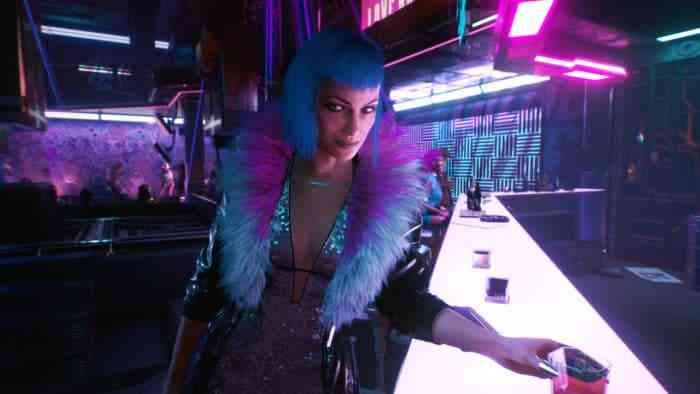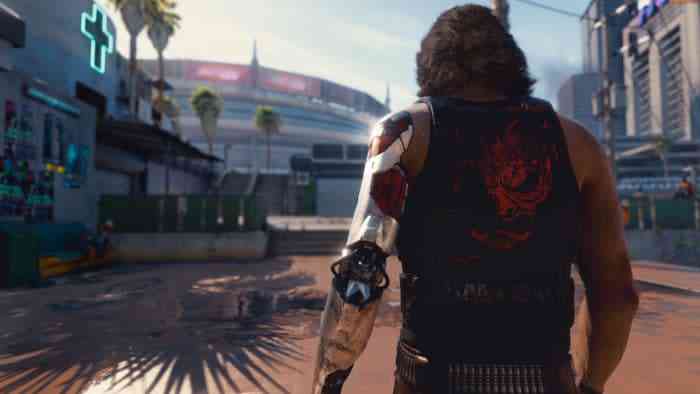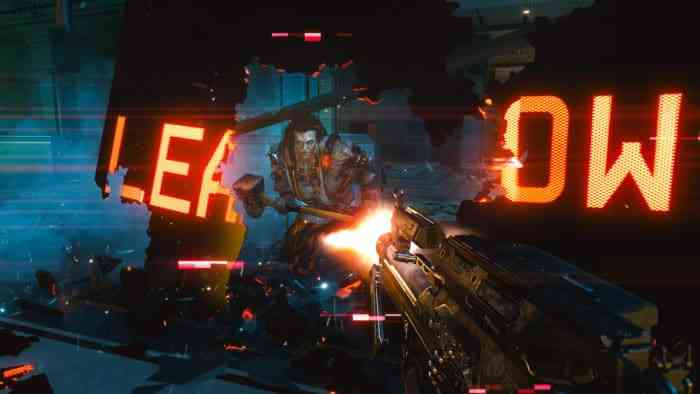Cyberpunk 2077 – Going Whoa In All The Wrong Ways
*sigh* Well, here we are. Eight years after being revealed Cyberpunk 2077 has finally released. Incredibly, it needed more time. A lot more time. And a long, sobering look at its goals and plans to get there. Cyberpunk 2077 is a confused experience that tries to do something for everyone and ends up failing more often than not. There are good pieces here, no doubt, but it lacks coherence and kicks itself in the cyberware every time it glances longingly at greatness.
Cyberpunk 2077 is also completely borked on consoles. This is, without doubt, the buggiest ‘finished’ game I’ve ever played. Yes, that includes Mass Effect Andromeda, and *shudder* Fallout 76. I cannot recommend paying money for this game on consoles right now. Most of this review will avoid discussing bugs except where necessary, but be aware that they have heavily impacted my experience and thus this review. Some of the more egregious include:
– Hard crashes to the Xbox dashboard
– Punching a window and being thrown several hundred meters back into the desert
– Overlapping, mismatched, and muted dialogue in main plot missions
– An enemy clipping through the floor, and then exploding like a grenade when grabbed
I could go on for ages (Seriously, ask anyone at COGconnected), but I’m not going to. I’d rather cover Cyberpunk 2077 itself, which tells the story of V.
I mean, it kind of does. In theory, V is whoever you want them to be. The character creator has a good deal of depth in some areas but is oddly devoid of choice in others. There’s a choice of three origin stories – I chose the Nomad path – that each unlock specific dialogue options throughout the game. These are primarily for flavour, and it was pretty rare that a Nomad speech check pushed the narrative forward in a meaningful way. It made my connection to V feel thin, even after 40 or 50 hours of time with her.
In fact, the only meaningful story beat related to V’s Nomad origin is the game’s tutorial mission. It was intriguing, teasing a lot of V’s history, and introducing us to Jackie: V’s soon-to-be partner in crime. The conclusion of that tutorial mission makes clear that Jackie and V are going to go into business together. We’re treated to a well-done montage of events where Jackie and V meet people, conduct heists, drink and dance, and generally grow their Night City reputation. The whole time I was thinking: why am I not playing these events? Maybe the parts that come after will be more impactful in building V’s character and her connection to Jackie?
The answers are I don’t know, and not really. It’s a bizarre design choice that directly impacts the experience of Cyberpunk 2077’s first act. Dropping back into the world with Jackie and V is like being the third wheel on what’s clearly a date. They already know each other and have a strong bond, and as a player you’re scrambling to understand what makes the relationship tick. It’s a problem that pervades the game as a whole.

V has a clear personality. Regardless of the choices you make to nudge her toward kindness or cruelty, V is always going to be V. As a player, you’re watching the events unfold while whispering suggestions into V’s ear. Situations may balloon out, but generally funnel back down to a singular outcome with some slight tweaks. You’re watching through V’s eyes, but you aren’t really her. The narrow range of outcomes makes you a passenger to the experience, not the one playing the lead role. It’s a fundamental issue that hounded me throughout the game. Cyberpunk 2077 has revolutionary role-playing game ambitions but delivers a story closer to Cyber Uncharted than to Deus Ex. Part of the disconnect has to do with the aforementioned time skip, but the vast majority is due to the construction of the world.
All Sizzle, No Steak
At first, I was desperate to dig into the world. To see how deep the rabbit hole might go. But the closer you get, the more you realize that Night City is a mile wide, but mere inches deep. The Wizard of Oz is blasting smoke and fire, but it’s far too easy to peer behind the curtain. Most doors are permanently locked or impossible to open, while NPCs have nothing interesting to say. There’s a ton of space to explore, but the payoffs are too few. They’re too thin. I’d gladly trade most of the dozens of random, unsatisfying gigs for more time with the interesting core characters. I wanted to care about Jackie, and Judy, and Vik, but the game doesn’t put in enough effort building those bonds.
Night City itself is vast and spectacular, a shining neon beacon of what humanity has become. It looks great, and packs some really excellent art design that backs up the game’s tone. Technology is the only thing keeping humanity going, and the design work here is top notch. When V first handles a new gun, it animates like a Transformer. Pieces shift and snap into place, making absolutely clear that this isn’t just a pistol, it’s a cyberpistol. It’s right in line with established properties like Blade Runner, but the aesthetic is consistent, and of really high quality. The seedy megabuildings scream Judge Dredd while billboards and TV ads show exactly how horny this world is.

Spoiler: it’s super horny. Cyberpunk 2077 is obsessed with being edgy and trying to shock you. It never landed for me. It’s clearly a design choice that was made, but I’m not convinced they pushed things in a new enough direction. Ads have the grossness dial cranked to 11, and that’s fine, but they generally fail to bring any nuance to the party. It comes off as cheap and adolescent, and it pushed me further away from engaging with the world.
Johnny, Won’t You Come On Home
The only thing really propelling me forward was the main story. Johnny Silverhand is a cool character, and while the way he and V link up isn’t exactly novel, it’s handled in such a way that I always wanted to see the next piece of the puzzle get placed. There are a few truly great moments peppered throughout, and it’s the little touches that really shone bright for me. As Johnny and V rub off on one another, small cues make that connection seem more believable. V’s increasing urge to light up a cigarette, for instance.
Keanu Reeves’ delivery is laid back and cool, though some of the line reads sound like they could have used a couple more takes. Meanwhile, I wasn’t blown away by female V’s voice acting – the tone between lines was all over the place, but that could be related more to direction and writing than the actual acting.
It always felt like the main missions were on the precipice of being something great. At one point, I had V steer a discussion down the path Johnny wanted, and he flashed a tiny thumbs up her way. It’s an insignificant detail, but the kind of thing you might see in a big budget, AAA RPG.
But inevitably, repeatedly, it all came crashing down. Just as I’d find the joy of playing this game, it ripped the fun right out of my hands. Most cutscenes and open world interactions suffered from incredible pacing issues. Many times, characters would be talking over each other to the point I wasn’t sure who was responding to whom. In other cases, important, impactful conversations would be drowned out by overly loud ads or derailed by multiple incoming text messages about cars for sale. In other cases quest scripting would be outright broken, forcing a reload of a past save to interact with a quest object.
And that’s during the main story threads. Things are far, far worse the minute you stray away from the critical path. For all the thought-provoking and enjoyable sections of the main quest, the quality of the side content is a giant step down in quality. Though some – such as the Delamain missions – are interesting and worth engaging with, the bulk come off as cheap, lazy, and poorly written. Huge tonal swings between line reads and poor dialogue flow actively pushed me away from the more investigative options. “This isn’t how people talk” isn’t something I ought to be thinking when playing a narrative-focused game. Obviously an open world has to have some activities totally divorced from the plot, but it’s where those two worlds cross that the gulf becomes most apparent.

Panam, a character from a main plot mission or two, pops up in several other quests. In them, the character behaves and speaks in a vastly different way. The spicy, my way or the highway Panam I’d grown rather fond of was replaced by a slapdash, ghost written, drug store novel copy. Awkward phrasing had alarm bells ringing right away, but the moment she began a statement with “Perhaps I shall”, I knew there was little hope of finding diamonds amongst Cyberpunk’s sandy sea of content. It’s as though an entirely different group of writers was responsible for side content, and none of them had guidance on the tone and voice of Night City’s world and residents. Worse still is knowing there are some good ones in the mix, and you might have to plow through 4 or 5 cringe inducing quests to find a good one.
Cyberpunk 2077 desperately needed a pair of outside eyes to do a slash and burn edit of this thing. It’s trying to do everything, all at once, but there’s no balance. It’s true for the narrative content, and equally true for its mechanical systems.
The game follows the classic Deus Ex system of choice. For each goal that needs accomplishing, there are multiple paths. You could sneak around the side of the building and hack a terminal if you have the technical know-how, or rip the back door open if you’re tough enough, or just shoot your way in if you haven’t specced in one particular direction. It works fine, but it’s stuff we’ve seen time and time again, and seen done better in the most recent Deus Ex titles.
The Cybermechanics At Work
At the mechanical core, Cyberpunk 2077 is a hardcore RPG. And taken alone, any one of the systems would be impressively robust. D&D-esque stat points pulled from a tabletop RPG fuel character growth, while a massive array of perks are available for building out V. Practically, I had a hard time finding much I wanted to chase. A 10% boost to stamina or passive health recovery are theoretically useful, but the rest of the game design actively works against those incentives.
Take stealth for instance. Being sneaky is fun, and bamboozling your foes with a limitless arsenal of hacks and body mods should be incredible. But, for one, stealth is busted and enemies will often see or hear you through walls. Besides that, this is an archaic stealth implementation. Areas of influence are sharply defined, and Guard A noticing you always means his pals in the region also immediately know where you are. It’s logically flawed, but it’s also crucially lacking any incentive to go to the trouble.
And that’s because simply shooting enemies is easier, faster, and has zero downside. I replayed many sections of Cyberpunk from a stealth perspective after taking the go loud path, and from what I can tell there’s no difference in outcome outside of – occasionally – a throwaway piece of dialogue. There’s no faction reputation to be won or lost, or different paths to unlock because you did things the hard way.

It’s a giant structural flaw. For all the talk about the Voodoo Boys and all the other gangs, there’s zero way to affect how you interact with them. And thus, no good reason to take any path but that of least resistance, mowing down everyone in sight. At the end of the day, everything you do earns you Street Cred regardless of your methods. Imagine the Paragon/Renegade system from Mass Effect, but the meter only goes up, and everything you do makes it go up. I don’t understand the purpose it serves, except to artificially gate progress and force engagement with bad side activities.
But it doesn’t actually force anything. Shooting is too effective. And thankfully, it feels serviceable. The default stick setup is atrocious, but after zeroing out all the acceleration and weird default dead zone settings, it’s comparable to how Fallout 4 feels. It’s good! Not Destiny 2 good, but a solid first effort. Smart guns and chargeable Tech weapons add much needed variety.
Driving, on the other hand, is downright bad. Think Ridge Racer on ice, but with cars stopped everywhere you’re supposed to do a cool drift. And bags of garbage are immovable barriers. A character called Claire offered to enter me in some street races, and I laughed aloud. Drive more? By choice? Absolutely not. When possible, I preferred to run or fast travel to avoid driving.

Getting Shit Done
Speaking of quality of life, let’s discuss Cyberpunk’s UI. To say it’s cumbersome would be far too kind. It’s confusing, illogical, and slow, and you’ll be using it a lot. The main menu stretches both horizontally and vertically, and controller navigation is unpredictable, but my main gripe is how selling and breaking down items works. Singularly. With each sold item, the UI must refresh, which also changes the organization of the list, requiring you to double check you’re not about to sell something you want. Every. Time. No bulk selling, no marking items as junk, no auto-best function. The menu interface is lifted almost directly from The Witcher 3, and I know you remember that system, dear readers. No direct map access button, no quick way to check on your quests – need I go on and on here? Quality of life features are almost certainly a victim of what I have to assume is a forced timeline, but that doesn’t improve the user experience.
The experience of playing Cyberpunk 2077 on the Xbox Series X is – graphically – ok. The quality mode provides decent visual quality at a reasonably steady 30 fps, while the performance mode offers a muddy presentation at 50-60 fps. Textures stream in well enough, but overall quality and performance are what I’d expect to see on a PS4 Pro or Xbox One X. And well, the game runs unacceptably poorly on the last gen platforms. I do think the assets and art work are very strong overall, but it’s difficult to appreciate when someone is often T posing or sliding up and down the stairs.
So now, 2500 words in, let’s talk about what this game is actually like. Ultimately, this isn’t the Cyber Witcher. Head for the hills if that’s what you’re expecting. The writing isn’t of that same caliber, and the kinds of interesting side experiences you’d find there are largely absent in Cyberpunk 2077. The closest games in terms of loop and structure are Fallout 4 and Deus Ex: Mankind Divided, but with a few caveats. Cyberpunk’s scope is a lot wider, but the density of interesting things is infinitely smaller. Things you can interact with are few and far between, with incredibly few named or interesting NPCs.
For Cyberpunk 2077 to be an outstanding game, one of two things needed to happen. Descoping of large portions of the game, and a structure more akin to an action RPG. A tighter focus akin to Rise of the Tomb Raider or even Prey could have allowed for more depth to the narrative experience. OR, alternatively, they could have leaned way further into the RPG elements of the game. Spend more time balancing and incentivizing the various half baked systems like Netrunning, and offer far more flexibility in how V can be role played. Of course, such a move would come at the expense of the high production value narrative CD Projekt Red wanted to create. As it turns out, even 8 years of development couldn’t make both – or either – of those outcomes happen. So is this a good game? Yes, sometimes, but only if they manage to sufficiently patch it.
*Xbox review code provided by the publisher*
The Good
- Great art design
- Johnny Silverhand quests
The Bad
- Buggiest game ever
- Extremely imbalanced
- Terrible user interface

